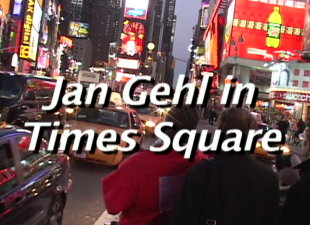Jan Gehl Joins Advocates to Talk Public Plazas in Low-Income Neighborhoods
Ask a New Yorker about the city’s plazas, and they’re likely to first think of Times Square. While the city’s marquee pedestrian space gets most of the attention, there are dozens of neighborhood-scale plazas across the city, with dozens more in the works in communities requesting them from DOT. Not all local groups have the financial might of Midtown Manhattan behind them, but there is still a need to maintain and support these spaces. Without city funds or donations, it can be hard to keep a good thing going — or to get it off the ground in the first place.

That’s where the Neighborhood Plaza Partnership (NPP) comes in. This group, a project of the Horticultural Society of New York, works with community groups that have signed on to be a plaza steward. Mostly, this involves pledging to keeping the space clean and organizing events in the plaza. But small merchants associations or non-profits often need a helping hand.
Last November, NPP received an $800,000 donation from the JPMorgan Chase Foundation to fund the upkeep of plazas in low-income communities. That money is helping support up to eight plazas this year, NPP’s Laura Hansen said. Today, her group and Transportation Alternatives hosted a panel discussion on the importance of plazas to low-income communities, featuring Danish architect and livable streets luminary Jan Gehl.
Plazas are a central component of healthy neighborhoods and cities, Gehl said. “Every good neighborhood should have a heart,” he said. “Public life and lively cities is very important for social inclusion and for democracy.” (Gehl’s point isn’t just theoretical: Last June, Queens Community Board 3 became the city’s first community board to meet in a public plaza.)
Although the plaza program was started by DOT, today’s event focused not on city government but on how different communities use and support their plazas. In addition to finding and sustaining funding, panelists said that local groups have to find a way to create events and programming that’s relevant to the city’s diverse population while maintaining an engaged group of volunteers.
“We have to take seriously how a plaza looks different in Brownsville or in the Bronx than it does in Times Square or Park Slope,” Council Member Brad Lander said during introductory remarks, which also connected plazas to Mayor de Blasio’s traffic safety goals. “They’re essential for moving forward street safety and the Vision Zero idea.”
In crowded neighborhoods like Corona, plazas function almost like an expansion of people’s living spaces. “It’s not just a matter of having a nice place to have your coffee. It’s for people who don’t have a living room,” said Prerana Reddy, director of public events at the Queens Museum of Art. “It’s for your psychological well-being…to be able to have your kids run around.”
At Corona Plaza, the Queens Museum is working with plaza maintenance partner Queens Economic Development Corporation to use the space as a venue for cultural and community events. Reddy said she and her staff work to make sure their programs include the neighborhood’s different cultures. The museum organized a Day of the Dead celebration in the plaza last year, but the neighborhood is home to immigrants from many Latin American nations, which celebrate the holiday differently. To accommodate as many people as possible, the museum designed a Day of the Dead program in the plaza that focused on immigration issues, which is a common denominator for many in the neighborhood.
“It’s about the culture of Corona,” she told Streetsblog. “We’re creating that culture together through the plaza.”
Programs like this are important, Reddy said, but a plaza’s vitality can’t rely solely on scheduled events. The Uni, an outdoor portable library, regularly sets up in Corona Plaza and other public spaces to both serve people walking through the area and attract more people to the space. Many neighbors have asked for vendors in the plaza, but Reddy said city regulations make it difficult to get the required approvals.
At Diversity Plaza in Jackson Heights, a once-skeptical group of merchants has taken on plaza maintenance, but members of the group are busy running their own businesses and have limited time to focus on the plaza. Working with Council Member Daniel Dromm, they’ve reached out to local environmental and civic organizations in Jackson Heights to recruit volunteers through a friends group. “It’s really been an all-volunteer, citizen-led effort,” said Shekar Krishnan of Friends of Diversity Plaza, but he cautioned that maintaining a volunteer organization is a challenge.
When there is funding out there to hire staff or launch programming, one grant usually doesn’t sustain a group over the long term. Hansen said that in addition to helping fund maintenance and operations, NPP aims to be a technical assistance center for local plaza groups that want help writing grant proposals or navigating application processes for funding.
Times Square Alliance president Tim Tompkins, who moderated today’s panel, noted that there is a bigger role for city government to play, as well. “What works in Times Square does not necessarily work in a neighborhood that doesn’t have those resources,” he said. “There’s got to be more government resources to balance that out.”
While NPP has so far relied on individual, foundation and corporate donations, Hansen said the group is looking for council members to dedicate some of their discretionary funds to plaza partners in their district. One of her goals for today’s event was to raise the profile of NPP’s role in helping local groups fund plaza maintenance.
“We’ve got to make sure every single city council person hears about this program,” she said.
